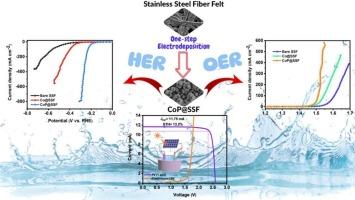Robust CoP-based bifunctional electrodes for 13.2 % efficient PV-driven water electrolysis in alkaline medium
IF 13.2
1区 工程技术
Q1 ENGINEERING, CHEMICAL
引用次数: 0
Abstract
The development of robust and efficient bifunctional non-precious metal-based electrodes for the oxygen evolution reaction (OER) and hydrogen evolution reaction (HER) is pivotal for enhancing the performance of PV-water electrolysis systems. In this study, we report a facile, one-step electrodeposition method for decorating stainless steel felt (SSF) with amorphous cobalt phosphate/phosphide (CoP) nanoparticles, yielding binder-free, conductive, and mechanically robust electrodes for HER and OER reactions in an alkaline environment. Benefiting from the homogeneous nanoparticle deposition, porosity, increased electrochemical surface area (ECSA), and strong interfacial contact between the CoP and SSF substrate, the optimized CoP@SSF electrode demonstrated outstanding OER performance, achieving overpotentials of 235 and 282 mV at current densities of 10 and 100 mA cm−2, respectively, with a Tafel slope of 51 mV dec−1. For HER, the same electrode exhibited an overpotential of 165 and 248 mV at 10 and 100 mA cm−2, respectively, with a Tafel slope of 65 mV dec−1, evincing that the developed electrode has bifunctionality and can serve at the OER and HER sides. Durability tests confirmed excellent stability over 25 h under continuous operation at 50 mA cm−2. Additionally, a laboratory-scale PV-water electrolyzer consisting of a triple junction InGaP/InGaAs/Ge solar cell and CoP@SSF bifunctional electrodes achieved a solar-to‑hydrogen conversion efficiency of 13.2 %. This work introduces a rapid and scalable strategy for developing robust CoP-based bifunctional electrodes, providing a promising route for demonstrating high-performance PV-water electrolysis systems for green hydrogen production from an alkaline medium.

稳健的钴基双功能电极,用于13.2 %高效的碱性介质中pv驱动的水电解
为析氧反应(OER)和析氢反应(HER)开发坚固高效的双功能非贵金属基电极是提高pv -水电解系统性能的关键。在这项研究中,我们报告了一种简单的一步电沉积方法,用无定形磷酸钴/磷化物(CoP)纳米颗粒装饰不锈钢毛毡(SSF),在碱性环境中产生无粘合剂、导电和机械坚固的HER和OER反应电极。得益于均匀的纳米颗粒沉积、孔隙度、电化学表面积(ECSA)的增加以及CoP和SSF衬底之间的强界面接触,优化后的CoP@SSF电极表现出出色的OER性能,在电流密度为10和100 mA cm−2时,过电位分别为235和282 mV, Tafel斜率为51 mV dec−1。对于HER,相同的电极在10和100 mA cm−2时的过电位分别为165和248 mV, Tafel斜率为65 mV dec−1,表明所开发的电极具有双功能,可以服务于OER和HER侧。耐久性试验证实,在50 mA cm−2的连续运行下,在25 h以上具有优异的稳定性。此外,由三结InGaP/InGaAs/Ge太阳能电池和CoP@SSF双功能电极组成的实验室规模的PV-water电解槽实现了13.2 %的太阳能-氢转换效率。这项工作介绍了一种快速和可扩展的策略,用于开发强大的基于cop的双功能电极,为展示用于碱性介质绿色制氢的高性能pv -水电解系统提供了一条有前途的途径。
本文章由计算机程序翻译,如有差异,请以英文原文为准。
求助全文
约1分钟内获得全文
求助全文
来源期刊

Chemical Engineering Journal
工程技术-工程:化工
CiteScore
21.70
自引率
9.30%
发文量
6781
审稿时长
2.4 months
期刊介绍:
The Chemical Engineering Journal is an international research journal that invites contributions of original and novel fundamental research. It aims to provide an international platform for presenting original fundamental research, interpretative reviews, and discussions on new developments in chemical engineering. The journal welcomes papers that describe novel theory and its practical application, as well as those that demonstrate the transfer of techniques from other disciplines. It also welcomes reports on carefully conducted experimental work that is soundly interpreted. The main focus of the journal is on original and rigorous research results that have broad significance. The Catalysis section within the Chemical Engineering Journal focuses specifically on Experimental and Theoretical studies in the fields of heterogeneous catalysis, molecular catalysis, and biocatalysis. These studies have industrial impact on various sectors such as chemicals, energy, materials, foods, healthcare, and environmental protection.
 求助内容:
求助内容: 应助结果提醒方式:
应助结果提醒方式:


